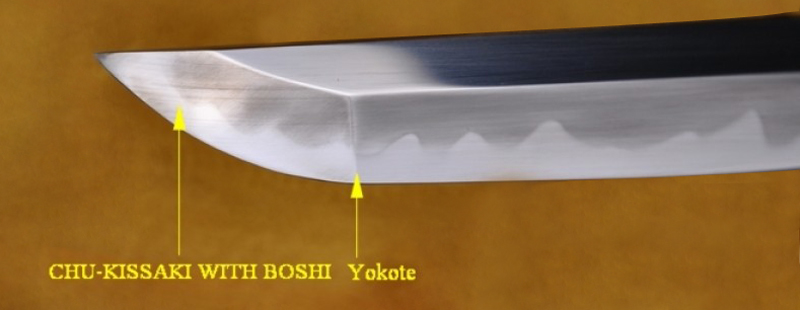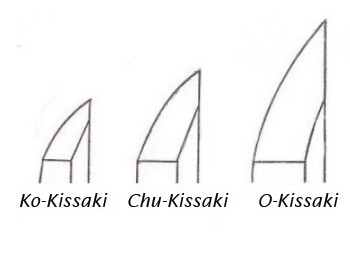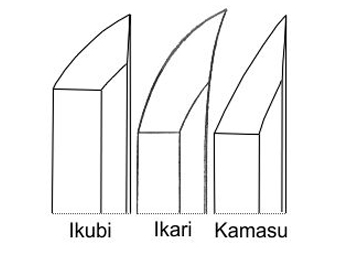Kissaki (切先) - The tip, or point of the Japanese Sword

The tip or point area of a samurai sword that has a ridge line (shinogi) is called a Kissaki. This is the hardest part of the sword to polish and forge and to hand create a quality one would require an extremely skilful artisan. The value of a sword is determined largely by the quality of the point.
The Kissaki and Boshi are often confused, the boshi is the pattern of the hamon in the tip area. This is also where you will find the Boshi which is the hardened edge section of the tip and the Yokote which is the dividing line where the surfaces change between the blade and the tip.
The size of the Kissaki is up to the blade maker but generally fall in Ko, Chu or O sizes which is small 3 cm, medium 4-6 cm and large 7-8 cm. There are also numerous shapes the kissaki can be, depending on what type period it was use.
Ko-kissaki (小切先 / Small Point)
Ko means 'small' and refers to the kissaki being of small proportion with respect to the rest of the blade. This form is typical of early Kamakura tachi.
It is the size (width) of the point relative to the width of the blade at the machi that makes this a Ko-kissaki. In other words, it is found on very tapered blades. Ko kissaki (small point) are found on very old blades, usually from Heian or Kamakura periods. It is small in comparison with the base of the blade, not necessarily short. The proportions are not very different from the normal kissaki, or chu kissaki.
Chu-kissaki (中切先 / Medium Point)
Chu means 'medium sized'. The width and the length of the kissaki are in good proportion. The length looks a little bigger than the width. Chu-kissaki is used from the mid-Kamakura period onwards and is the most common and will be found on the majority of production swords.
O-kissaki (大切先 / Large Point)
"O" means "large". The kissaki length is far larger than the width. It looks emphatic for eyes. This type started in 14th century. It appears on large blades, over 90 cm long. The blade width also is large towards the kissaki and it is proportional to the length. But the thickness doesn't become so large. An O-kissaki is one which is large in proportion to the rest of the blade.
Ikubi Kissaki (“boars neck”)
Ikubi means 'boar's neck'. It is a short kissaki and looks robust and steady. It is a kissaki whose length is shorter than the saki haba (the width of the blade at the yokote)
Ikari Kissaki
The Ikari has a tip that sweeps upward and the Kamsu which which is named after a fish. This is also what we refer to as a tanto tip commonly used for ninjato or shinobigatana.
Kamasu-Kissaki (Barracuda Point)
Kamasu refers to a kind of fish with a long beak. So called because its shape resembles the head of the fish. A very large kissaki with an almost straight edge (has little curve, or Fukura). Possessing the rounded edge similar to that of a barracuda this type dates back to the Heian period. This is sometimes simply known as Barracuda point.
Want a unique sword? Feel free to contact us:
Phone: 086 13739276006
Email: [email protected]
Website: www.hanbonforge.com
Custom Sword Page: www.hanbonforge.com/CUSTOM-SWORDS/Custom-Your-Own-Swords




Leave a Comment